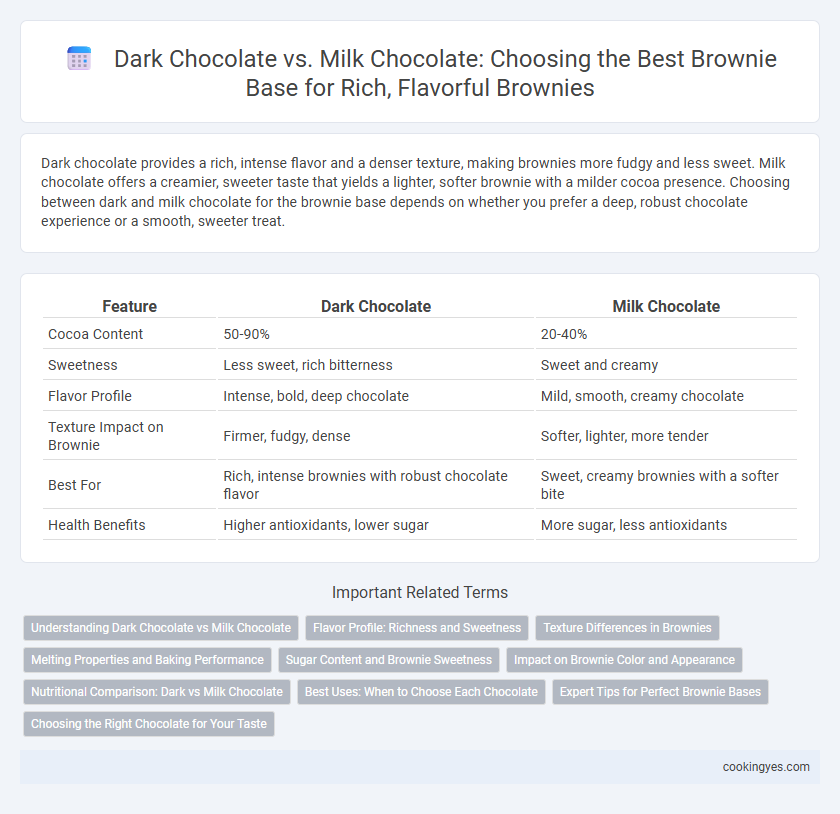Dark chocolate provides a rich, intense flavor and a denser texture, making brownies more fudgy and less sweet. Milk chocolate offers a creamier, sweeter taste that yields a lighter, softer brownie with a milder cocoa presence. Choosing between dark and milk chocolate for the brownie base depends on whether you prefer a deep, robust chocolate experience or a smooth, sweeter treat.
Table of Comparison
| Feature | Dark Chocolate | Milk Chocolate |
|---|---|---|
| Cocoa Content | 50-90% | 20-40% |
| Sweetness | Less sweet, rich bitterness | Sweet and creamy |
| Flavor Profile | Intense, bold, deep chocolate | Mild, smooth, creamy chocolate |
| Texture Impact on Brownie | Firmer, fudgy, dense | Softer, lighter, more tender |
| Best For | Rich, intense brownies with robust chocolate flavor | Sweet, creamy brownies with a softer bite |
| Health Benefits | Higher antioxidants, lower sugar | More sugar, less antioxidants |
Understanding Dark Chocolate vs Milk Chocolate
Dark chocolate provides a richer, more intense cocoa flavor with higher cocoa content, typically ranging from 50% to 90%, which enhances the deep, fudgy texture of brownies. Milk chocolate contains a lower percentage of cocoa solids, usually between 10% to 50%, and includes more sugar, milk solids, and fat, resulting in a sweeter, creamier base that yields a softer, lighter brownie. Choosing dark chocolate emphasizes bitterness and complexity, while milk chocolate offers a milder, sweeter profile ideal for those who prefer less intense chocolate flavor.
Flavor Profile: Richness and Sweetness
Dark chocolate offers a deep, intense richness with a slightly bitter undertone that enhances the complexity of brownie bases, creating a bold and sophisticated flavor profile. Milk chocolate provides a sweeter, creamier taste with a smooth, mellow richness that results in a softer, more indulgent brownie texture. The choice between dark and milk chocolate directly influences the balance of sweetness and depth, catering to preferences for either robust or sweeter brownie experiences.
Texture Differences in Brownies
Dark chocolate creates a denser, fudgier brownie texture due to its higher cocoa content and lower sugar levels, resulting in a rich, intense flavor profile. Milk chocolate yields a lighter, more tender crumb with a creamier mouthfeel, attributed to its higher sugar and milk fat content that softens the batter. Selecting dark or milk chocolate directly influences the brownie's moistness, chewiness, and overall textural experience.
Melting Properties and Baking Performance
Dark chocolate offers superior melting properties due to its higher cocoa content and lower sugar levels, resulting in a richer, fudgier brownie base with a denser texture. Milk chocolate, containing more milk solids and sugar, melts at a lower temperature, providing a creamier, sweeter flavor but a lighter, less dense crumb structure. For baking performance, dark chocolate maintains its structure better during the baking process, ensuring a moist yet firm brownie, whereas milk chocolate may lead to a softer, more cake-like consistency due to its composition.
Sugar Content and Brownie Sweetness
Dark chocolate contains less sugar than milk chocolate, resulting in a less sweet brownie base that highlights rich, intense cocoa flavors. Milk chocolate, with its higher sugar content, produces a sweeter, creamier brownie that appeals to those preferring a milder chocolate taste. Choosing between dark and milk chocolate directly impacts the overall sweetness and balance of a brownie, affecting both texture and flavor profile.
Impact on Brownie Color and Appearance
Dark chocolate produces brownies with a rich, deep brown color and a glossy, slightly cracked surface, enhancing visual appeal and suggesting intense cocoa flavor. Milk chocolate results in lighter-colored brownies with a softer, creamier appearance, often yielding a more cake-like texture. The choice between dark and milk chocolate significantly influences the brownie's overall aesthetic and perceived richness.
Nutritional Comparison: Dark vs Milk Chocolate
Dark chocolate contains higher levels of antioxidants and lower sugar content compared to milk chocolate, making it a healthier choice for brownie bases. Milk chocolate typically has more added sugars and fats, which can increase calorie count and reduce nutritional value. Opting for dark chocolate enhances the brownie's richness while providing beneficial flavonoids and less sugar for a more nutritious dessert.
Best Uses: When to Choose Each Chocolate
Dark chocolate offers a rich, intense flavor and is ideal for brownies requiring a deep cocoa taste and a fudgy texture, making it perfect for sophisticated desserts or pairing with strong coffee. Milk chocolate provides a sweeter, creamier profile suited for lighter, sweeter brownies that appeal to those preferring a mild chocolate experience, often used in family-friendly or kid-focused recipes. Choosing dark chocolate enhances bitterness and complexity, while milk chocolate adds smoothness and sweetness to the brownie base.
Expert Tips for Perfect Brownie Bases
Dark chocolate enhances brownie bases with richer cocoa flavor and a fudgier texture, favored by experts for bold, intense results. Milk chocolate contributes a sweeter, creamier profile, creating lighter, softer brownies ideal for those preferring milder sweetness. Professional bakers recommend using at least 60-70% cocoa content dark chocolate for optimal balance of bitterness and sweetness in classic brownie bases.
Choosing the Right Chocolate for Your Taste
Dark chocolate offers a rich, intense flavor and higher cocoa content, ideal for those who prefer a deep, slightly bitter taste in their brownies. Milk chocolate provides a sweeter, creamier profile with lower cocoa percentage, perfect for a mellow, smooth base that balances sweetness and texture. Selecting the right chocolate depends on your desired flavor intensity and sweetness level to create the perfect brownie base tailored to your taste preferences.
Dark Chocolate vs Milk Chocolate for Brownie Base Infographic

 cookingyes.com
cookingyes.com